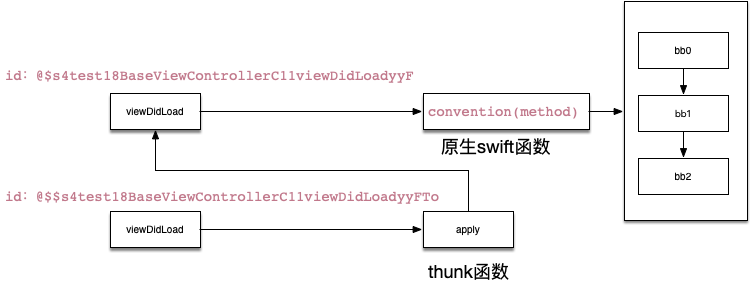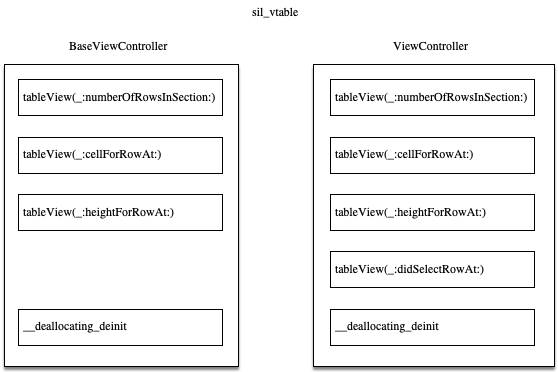由一个实际问题引出的Swift与ObjC交互性讨论
本篇文章由一个项目中的实际问题引出,TableView是常用的基础控件,我们经常在一个基类中实现Tableview的基础代理方法,然后再根据业务需求情况,设计不同的子类继承基类,重写部分代理方法,简化业务实现。我们要探讨的问题就在继承中出现。。。。
问题引出
先来看这段代码,是常见的tableView相关的使用场景
protocol ListDataProtocol {
}
class BaseViewController<P: ListDataProtocol>:UIViewController,UITableViewDelegate,UITableViewDataSource {
var tableView: UITableView
var presenter: P?
override func viewDidLoad() {
//省略非必要实现细节
}
override init(nibName nibNameOrNil: String?, bundle nibBundleOrNil: Bundle?) {
//省略非必要实现细节
}
required init?(coder: NSCoder) {
//省略非必要实现细节
}
//MARK: UITableViewDataSource
// cell的个数
func tableView(_ tableView: UITableView, numberOfRowsInSection section: Int) -> Int {
return 10
}
// UITableViewCell
func tableView(_ tableView: UITableView, cellForRowAt indexPath: IndexPath) -> UITableViewCell {
//省略非必要实现细节
}
//MARK: UITableViewDelegate
// 设置cell高度
func tableView(_ tableView: UITableView, heightForRowAt indexPath: IndexPath) -> CGFloat {
return 44.0
}
}
class ListData: NSObject, ListDataProtocol{
}
class ViewController: BaseViewController<ListData> {
override func viewDidLoad() {
super.viewDidLoad()
// Do any additional setup after loading the view.
}
// 选中cell后执行此方法
func tableView(_ tableView: UITableView, didSelectRowAt indexPath: IndexPath) {
print(indexPath.row)
}
}
首先我们简单了解一下这段代码,基类BaseViewController包含iOS中UITableView的DataSource和Delegate的基础实现,子类ViewController继承基类,由于基类中不知道如何处理具体的业务细节,所以只包含必须的代理实现,而其他可选的代理实现,预期由子类实现,所以在子类ViewController中实现了table(_:didSelectRowAt:),用于处理Cell选中事件,那么问题来了,请问执行这段代码时,点击cell是否会如预期输出print(indexPath.row)

答案是:没有输出,table(_:didSelectRowAt:)不会被调用执行,那么为什么呢?
显然我们查找文档和Google都不能很容易找到答案,所以想到了利用Swift提供的中间语言SIL(Swift Intermediate Language),如果你不了解SIL,建议首先阅读 Swift Intermediate Language 初探
生成SIL
swiftc -emit-silgen -target x86_64-apple-ios13.0-simulator -sdk $(xcrun --show-sdk-path --sdk iphonesimulator) -Onone test.swift > test.swift.sil
- 由于我们需要使用到UIKit这类系统库,所以需要使用-sdk参数指定依赖的SDK路径
- -target 指定生成代码对应的target
- -Onone 不进行任何优化
SIL分析
thunk函数
thunk函数,是一个不得不提的概念,我借用阮一峰老师博客一段话来说明:
编程语言刚刚起步时,编译器怎么写比较好。一个争论的焦点是“求值策略”,即函数的参数到底应该何时求值。
var x = 1;
function f(m){
return m * 2;
}
f(x + 5)
一种意见是“传值调用”(call by value),即在进入函数体之前,就计算 x + 5 的值(等于6),再将这个值传入函数 f 。C语言就采用这种策略。
f(x + 5) // 传值调用时,等同于 f(6)另一种意见是“传名调用”(call by name),即直接将表达式 x + 5 传入函数体,只在用到它的时候求值。Hskell语言采用这种策略。
f(x + 5) // 传名调用时,等同于 (x + 5) * 2传值调用和传名调用,哪一种比较好?回答是各有利弊。传值调用比较简单,但是对参数求值的时候,实际上还没用到这个参数,有可能造成性能损失。
编译器的”传名调用”实现,往往是将参数放到一个临时函数之中,再将这个临时函数传入函数体。这个临时函数就叫做 Thunk 函数。
Swift SIL当中的thunk函数的基本思想与上面描述的是一致的,但是作用稍有不同,我们来看文章开头这个例子中,BaseViewController.viewDidLoad函数对应的SIL片段,借此了解thunk函数的作用。
// BaseViewController.viewDidLoad()
sil hidden [ossa] @$s4test18BaseViewControllerC11viewDidLoadyyF : $@convention(method) <P where P : ListDataProtocol> (@guaranteed BaseViewController<P>) -> () {
// %0 // users: %89, %88, %87, %80, %79, %78, %72, %71, %53, %11, %10, %2, %1
bb0(%0 : @guaranteed $BaseViewController<P>):
//暂时省略无关代码
bb1: // Preds: bb0
//暂时省略无关代码
// %70 // users: %77, %75, %74
bb2(%70 : @owned $UIView): // Preds: bb0
//暂时省略无关代码
} // end sil function '$s4test18BaseViewControllerC11viewDidLoadyyF'
// @objc BaseViewController.viewDidLoad()
sil hidden [thunk] [ossa] @$s4test18BaseViewControllerC11viewDidLoadyyFTo : $@convention(objc_method) <P where P : ListDataProtocol> (BaseViewController<P>) -> () {
// %0 // user: %1
bb0(%0 : @unowned $BaseViewController<P>):
//暂时省略无关代码
// function_ref BaseViewController.viewDidLoad()
%3 = function_ref @$s4test18BaseViewControllerC11viewDidLoadyyF : $@convention(method) <τ_0_0 where τ_0_0 : ListDataProtocol> (@guaranteed BaseViewController<τ_0_0>) -> () // user: %4
%4 = apply %3<P>(%2) : $@convention(method) <τ_0_0 where τ_0_0 : ListDataProtocol> (@guaranteed BaseViewController<τ_0_0>) -> () // user: %7
//暂时省略无关代码 // id: %7
} // end sil function '$s4test18BaseViewControllerC11viewDidLoadyyFTo'
由于篇幅所限,这段代码中省略了一些解释问题非必要的代码,如果需要查看完整代码请参见文末下载地址。
你会发现生成了两段viewDidLoad,第一段是一个原生的Swift函数,使用convention(method)方式调用和处理,它内部有三个block块,分别实现一些具体的功能:bb0完成一些变量的分配和初始化;bb1完成代码诊断相关工作;bb2完成BaseViewController中TableView的Delegate和DataSource的设置,这三部分构成了完整的viewDidLoad函数。
第二段,它是一个thunk函数,它的标识id是@$$s4test18BaseViewControllerC11viewDidLoadyyFTo,对比一下第一段id是@$s4test18BaseViewControllerC11viewDidLoadyyF,第二段的id是在第一段的基础上增加了两个单词To,并且通过@convention(objc_method)可以看到,它是使用ObjC方式调用的;它的内部使用Swift原生方式调用第一段的函数;
整个流程如下图所示:

简单总结一下,在SIL中生成了一个新的thunk函数,这个函数用于暴露给ObjC进行交互,而thunk函数内部会调用真正的原生Swift函数。那么也就是说,如果一个函数需要被ObjC可见,需要包装为一个支持ObjC方式调用的thunk函数。
Swift消息派发方式
简单来说,Swift有两种消息派发方式:
- 静态派发(static dispatch),静态派发在执行的时候,会直接跳到方法的实现,静态派发可以进行inline和其他编译期优化,值类型总是会使用静态派发,因为不存在继承可变的可能;
- 动态派发(dynamic dispatch),动态派发在执行的时候,会根据运行时(Runtime),采用table的方式,找到方法的执行体,然后执行。动态派发也就没有办法像静态派发那样,进行编译期优化。
有些文章还会提到,第三种派发方式,Objective-C派发,其实Swift代码当中的这种方式的本质就是我们前面提到的thunk函数机制,它涉及两个Swift关键字@objc和dynamic:@objc意味着你的Swift代码,如类,方法,属性,将会被Objective-C可见;dynamic意味着你要是用Objective-C动态派发;
但是这两个参数其实并不是单独使用的,如果使用了dynamic就必须添加@objc,但是反过来可以单独@objc,区分开来使得每个关键字的含义更清晰。使用@objc和dynamic组合生成的函数,采用Objective-C派发,不会出现在SIL的VTable表中的;而单独添加@objc的函数是会出现在VTable表中的, 采用的Swift动态派发。
另外,需要提到的是@objc可见性,在Swift4以前,从NSObject继承的类中的方法是由编译器自动暴露给Objective-C可见,但是从Swift4以后,需要手动添加@objc明确指明,编译器不再进行推断。反映到SIL也是一致的,如果生成的函数标记为@objc才能被Objective-C可见。
关于VTable和Witness Table如果不很了解,建议还是先阅读Swift Intermediate Language 初探
答案探寻
有了前面的基础,我们来探索答案,把焦点定位到table(_:didSelectRowAt:)关键字
sil_vtable BaseViewController {
//暂时省略无关代码
#BaseViewController.tableView!1: <P where P : ListDataProtocol> (BaseViewController<P>) -> (UITableView, Int) -> Int : @$s4test18BaseViewControllerC05tableC0_21numberOfRowsInSectionSiSo07UITableC0C_SitF // BaseViewController.tableView(_:numberOfRowsInSection:)
#BaseViewController.tableView!1: <P where P : ListDataProtocol> (BaseViewController<P>) -> (UITableView, IndexPath) -> UITableViewCell : @$s4test18BaseViewControllerC05tableC0_12cellForRowAtSo07UITableC4CellCSo0jC0C_10Foundation9IndexPathVtF // BaseViewController.tableView(_:cellForRowAt:)
#BaseViewController.tableView!1: <P where P : ListDataProtocol> (BaseViewController<P>) -> (UITableView, IndexPath) -> CGFloat : @$s4test18BaseViewControllerC05tableC0_14heightForRowAt12CoreGraphics7CGFloatVSo07UITableC0C_10Foundation9IndexPathVtF // BaseViewController.tableView(_:heightForRowAt:)
#BaseViewController.deinit!deallocator.1: @$s4test18BaseViewControllerCfD // BaseViewController.__deallocating_deinit
}
sil_vtable ViewController {
//暂时省略无关代码
#BaseViewController.tableView!1: <P where P : ListDataProtocol> (BaseViewController<P>) -> (UITableView, Int) -> Int : @$s4test18BaseViewControllerC05tableC0_21numberOfRowsInSectionSiSo07UITableC0C_SitF [inherited] // BaseViewController.tableView(_:numberOfRowsInSection:)
#BaseViewController.tableView!1: <P where P : ListDataProtocol> (BaseViewController<P>) -> (UITableView, IndexPath) -> UITableViewCell : @$s4test18BaseViewControllerC05tableC0_12cellForRowAtSo07UITableC4CellCSo0jC0C_10Foundation9IndexPathVtF [inherited] // BaseViewController.tableView(_:cellForRowAt:)
#BaseViewController.tableView!1: <P where P : ListDataProtocol> (BaseViewController<P>) -> (UITableView, IndexPath) -> CGFloat : @$s4test18BaseViewControllerC05tableC0_14heightForRowAt12CoreGraphics7CGFloatVSo07UITableC0C_10Foundation9IndexPathVtF [inherited] // BaseViewController.tableView(_:heightForRowAt:)
#ViewController.tableView!1: (ViewController) -> (UITableView, IndexPath) -> () : @$s4test14ViewControllerC05tableB0_14didSelectRowAtySo07UITableB0C_10Foundation9IndexPathVtF // ViewController.tableView(_:didSelectRowAt:)
#ViewController.deinit!deallocator.1: @$s4test14ViewControllerCfD // ViewController.__deallocating_deinit
}
由于基类BaseViewController中没有实现table(_:didSelectRowAt:),所以基类sil_vtable表中没有对应函数签名,这很正常;子类ViewController有实现,所以出现table(_:didSelectRowAt:),但是请注意它不是一个thunk函数。
对比如下图所示:

再看table(_:didSelectRowAt:)的实现部分SIL
// ViewController.tableView(_:didSelectRowAt:)
sil hidden [ossa] @$s4test14ViewControllerC05tableB0_14didSelectRowAtySo07UITableB0C_10Foundation9IndexPathVtF : $@convention(method) (@guaranteed UITableView, @in_guaranteed IndexPath, @guaranteed ViewController) -> () {
// %0 // user: %3
// %1 // users: %13, %4
// %2 // user: %5
bb0(%0 : @guaranteed $UITableView, %1 : $*IndexPath, %2 : @guaranteed $ViewController):
//省略内部实现
} // end sil function '$s4test14ViewControllerC05tableB0_14didSelectRowAtySo07UITableB0C_10Foundation9IndexPathVtF'
首先没有@objc的标记,没有thunk的标记,所以根据前面的知识可得,虽然ViewController实现了table(_:didSelectRowAt:),但是这个函数在生成的SIL中是一个纯粹的原生Swift函数,编译器没有帮助它生成对应的Objective-C可见的thunk函数,所以无法被UITabview回调使用,到此我们已经回答了开头的问题。
那么为什么编译器不去生成呢?什么情况下编译器会生成thunk函数呢?
对比试验
我们先来做两个对比试验:
Test1
开篇问题的代码中,如果你删除跟presenter泛型相关的代码,删除ListDataProtocol协议,重新运行一下,结果。。。。print(indexPath.row)正常输出了,怎么解释呢???
我们还是借助SIL语言,分析去掉前述内容后生成的SIL:
- ViewController的sil_vtable表中有
table(_:didSelectRowAt:)与当前一致; - 除原始的
table(_:didSelectRowAt:)实现外,生成了带@objc标记的thunk函数; - BaseViewController和ViewController都被直接标记为@objc(没有泛型,都是基于UIKit,需要依赖Objective-C runtime,所以可以被默认推断Objective-C可见)
Test2
还是开篇问题的代码中,如果在基类实现table(_:didSelectRowAt:),在子类修改table(_:didSelectRowAt:)添加override,重新运行一下,执行结果:print(indexPath.row)正常输出
查看修改后生成的SIL:
- 基类BaseViewController和子类的ViewController各自的sil_vtable中,都有
table(_:didSelectRowAt:),且子类中对应方法标记为[override] - 除原始的
table(_:didSelectRowAt:)实现外,生成了带@objc标记的thunk函数; - BaseViewController和ViewController没有被标记@objc
对比一下,相同点,都生成了thunk函数,所以结果能够正常输出!不同点,没有泛型情况,编译器默认推断生成Objc可见;有泛型情况,只有基类实现对应方法,子类的实现方法才会被编译器推断生成thunk函数。
小结
查阅SIL的官方文档有这样一段话:
If a derived class conforms to a protocol through inheritance from its base class, this is represented by an inherited protocol conformance, which simply references the protocol conformance for the base class.
简单翻译一下:
如果派生类通过从其基类继承而符合协议,这种称为继承协议一致性表示(inherited protocol conformance),它会简单引用基类的协议实现
这句话就可以解释我们的问题了,设计编译器时在这种场景下,它只会简单引用基类的实现,所以基类中必须有table(_:didSelectRowAt:),子类的table(_:didSelectRowAt:)才会被可见!
猜想
在文章的末尾,我想再提出一个问题,我们大胆猜想一下为什么编译器设计为简单引用基类的协议实现,我认为是编译效率的考量!以Tableview为例,它的DataSource和Delegate中绝大部分是可选的实现,如果编译器不按照现在的逻辑处理,就需要层层遍历所有子类,查找所有可能的代理函数实现,然后把他们都转成thunk函数,才能实现文章开头的预期效果,显然是一个十分耗时的过程,并且这样操作就如同swift调整@objc的推断一样,是在代替使用者做决策。
如有错误欢迎批评指正!
所有源文件下载地址
参考
- https://en.wikipedia.org/wiki/Thunk
- https://swiftunboxed.com/interop/objc-dynamic/
- https://github.com/apple/swift-evolution/blob/master/proposals/0160-objc-inference.md
- https://useyourloaf.com/blog/objc-warnings-upgrading-to-swift-4/
- https://medium.com/@slavapestov/how-to-talk-to-your-kids-about-sil-type-use-6b45f7595f43